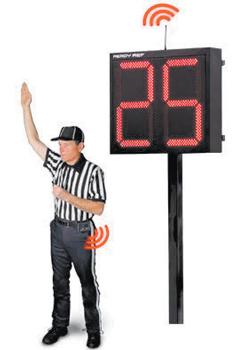 A change in how the clock is started when returning to play and the option of adding instant replay to state playoff competitions highlight the high school football rules changes for this year announced by the National Federation of State High School Associations.
A change in how the clock is started when returning to play and the option of adding instant replay to state playoff competitions highlight the high school football rules changes for this year announced by the National Federation of State High School Associations.
Neil Buie, regional supervisor of football officials for the Cape Fear region, thinks the new rules about what was the 25-second clock that times the period before the next play begins will have the biggest impact on the game this fall.
The purpose of the rule is to establish more consistency in the time period between downs.
“From referee to referee, there is a real difference in when the clock is blown ready for play,’’ Buie said. In the case of a referee who quickly sets the ball ready for play and starts the clock, as many as 15 or 20 more plays can be run per game than in a contest with a referee who is slower to mark the ball ready.
Under the new rule, as soon as the ball is declared dead by an official, the 40-second clock begins ticking. But there are exceptions. It will be set to 25 seconds before the extra point attempt after a touchdown, at the start of a quarter or overtime, after an inadvertent whistle, after a charged time-out or following an official’s timeout or other stoppage of the clock by the referee for any other reason.
Buie thinks some training of clock operators will be needed to deal with the timing changes.
Another minor problem could be resetting the 25-second clock to 40 seconds. Most modern 25-second clocks can be adjusted with little difficulty to display a 40-second countdown. If schools have older clocks, however, they might need to purchase new control panels or have the old one updated.
Another issue officials often encounter at schools is that the 25-second clocks don’t work. Buie wonders if the back judge will have to be responsible for the 40-second clock if it’s not working.
Another potential major change is the addition of instant replay to state playoff games if approved by that state’s athletic association. For North Carolina, this would require action by the North Carolina High School Athletic Association.
Buie thinks it’s likely that replay could only be implemented at the state championship level when the NCHSAA plays its football title games at various major college stadiums around the state.
He’s doubtful it could be implemented at a high school stadium in a playoff game because there likely would not be enough camera angles to make it worthwhile. He added it would also be difficult to either have someone in the press box looking at a monitor or have someone bring a laptop to the field so one of the officials could view it.
A rule change that is not a big deal to players, coaches and officials but that definitely brought smiles to members of the media involves the numbers on football jerseys. Effective with the 2024 season, the numbers must be a single solid color that contrasts with the body color of the jersey.
In recent years, many schools have started wearing jerseys with numbers the same color as the body of the jersey, with the number faintly outlined by a contrasting color. In other cases, schools wore white jerseys with numbers of a light color, like gold or yellow on white for example, making them difficult to read from a distance.
Trey Edge, who does radio play-by-play for DK Sports, Inc., praised the new rule.
“It is long overdue,’’ he said. “One of the reasons we do high school broadcasts is to publicize what the kids in Cumberland County are doing. It is difficult to do that when you cannot get correct numbers, especially when there is a scrum of a lot of people.’’
Edge said when the numbers almost bleed into the jersey in a fast-moving game, it becomes a challenge to make out something as simple as who is carrying the football. “It should not be that difficult,’’ he said. He called the new rule a big win.
Other changes to high school football rules announced by the NFSHSA include the following:
• Tripping a runner is now officially illegal. A runner was not previously mentioned in the definition of tripping.
• The horse-collar tackling rule, which prohibits grabbing inside the shoulder pads to take down a runner, has been expanded. Grabbing the nameplate area of a runner’s jersey immediately below the rear collar is also illegal.
• A legal scrimmage formation now requires only five offensive players on the line, not seven. Also, there can be no more than four offensive backs. It’s hoped this change will allow the officials to have an easier time watching for legal and illegal offensive formations.
• The penalty for illegally kicking or batting a ball has been reduced from 15 yards to 10 yards.
For a complete list of the football rules changes for 2019, go to www.nfhs.org. Click on the link for activities and sports at the top of the page and then choose football.
A survey conducted by the NFSHSA in 2017-18 showed 11-player football is the most popular sport for boys in the United States. There are 14,079 schools fielding teams with 1,036,842 boys participating nationally.
There are some 30,000 boys taking part in sixman, eight-man and nine-man football. In addition, there are some 2,500 girls playing high school football, which results in a total of 1,068,870 players taking part in the game at the high school level.

 How to resolve AdBlock issue?
How to resolve AdBlock issue? 








